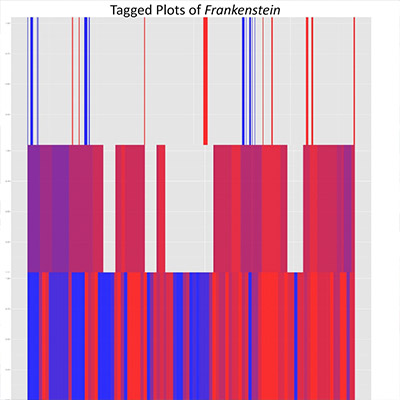Suspense
About the project
Status: archive
Project team: Mark Algee-Hewitt, Abigail Droge, Erik Fredner, J.D. Porter, Tasha Eccles, Oleg Sobchuk, Hannah Walser;
Collaborators: Chelsea Davis, Laura Eidem;
Start date: Sep 1, 2014
End date: Jan 1, 2018
Last updated: Jan 1, 2023

As a textual phenomenon that seems to rely exclusively on the affective states of an audience, suspense would appear to be well outside of the quantifiable aspects of literature that are available to Digital Humanities study. Even while suspense can be understood as a genre of writing, this generic label is relegated to a relatively small group of texts, ignoring the way that many other genres, for example, horror, science fiction, mysteries and thrillers, also make use of the same phenomenon. Compounding these difficulties, suspense is also a descriptive category that can be applied at the inter-textual level (works can be “suspenseful”) as well as at the intra-textual level (certain parts of works can be “suspenseful”). Finally, suspense can also manifest itself as an epiphenomenon of narrative: disentangling the “momentum” of narrative propulsion from the existential suspense of genre fiction further complicates studies attempting to isolate the origins of suspense effects.
Recent work, however, has suggested that careful digital parsing of narrative might provide clues to the origins of this effect. Richard Doust’s study, “Narrative structures: the case of suspense” argues that if narrative units can be digitally coded then their pattern can reveal the mechanisms of suspense. While very promising, this work relies extensively on pre-coded (and thus pre-defined) narrative units restricting its generalizability across time and genres. Yet the promise of this work is tantalizing. If it is possible to locate lexical or semantic features that are related to the experience of suspense, we would not only gain a much deeper understanding of what suspense is, but we would also be able to investigate narrative processes at the scale of corpora in a way that current Digital Humanities work cannot. Moreover, such an analysis would also offer a potential bridge between the often rigidly formalist approaches characteristic of quantitative textual analysis and the primarily subjective domain of the reader’s affective experience.
In this project, “Suspense: Language, Narrative, Affect,” we seek to unpack the transhistorical and transgeneric commonalities of suspense literature. Our goal is to isolate lexical and narrative features that, within the right context, create the potential for the experience of suspense. Drawing on previous narratological and psychological studies, it is our contention that suspense, as a psychological affect, occurs in the negotiation between the reader and the text. That is, we argue that there are textual effects that create the potential for the experience of suspense, which are only realized by a reader encountering the text within a specific context.
As part of our goal in this project is to trace these textual features both across time and across genres that are, to varying degrees, “suspenseful,” we have assembled a corpus of 216 texts from between 1780 and 2013 that were unanimously deemed suspenseful by the project group. These texts not only belong to the genre of “suspense literature,” but also to a variety of genres for which suspense is an important component, including Gothic fiction, detective fiction, sensation literature, science fiction and horror. As a control, we also created a corpus of 107 “unsuspenseful” texts sampled from the same time period. To explore both the textual and affective components of suspense we apply a set of established digital humanities methods to uncover textual features shared by suspenseful texts (or suspenseful episodes within texts) combined with collaborative social psychological work to explore how these textual features impact reader experience. Through this project we investigate: 1. Is, in fact, the experience of suspense common among a group of readers; 2. Are there lexical features that are shared by suspenseful narratives or narrative episodes and 3. Do these features form identifiable patterns within narratives that are common among our historically and generically diverse corpus?